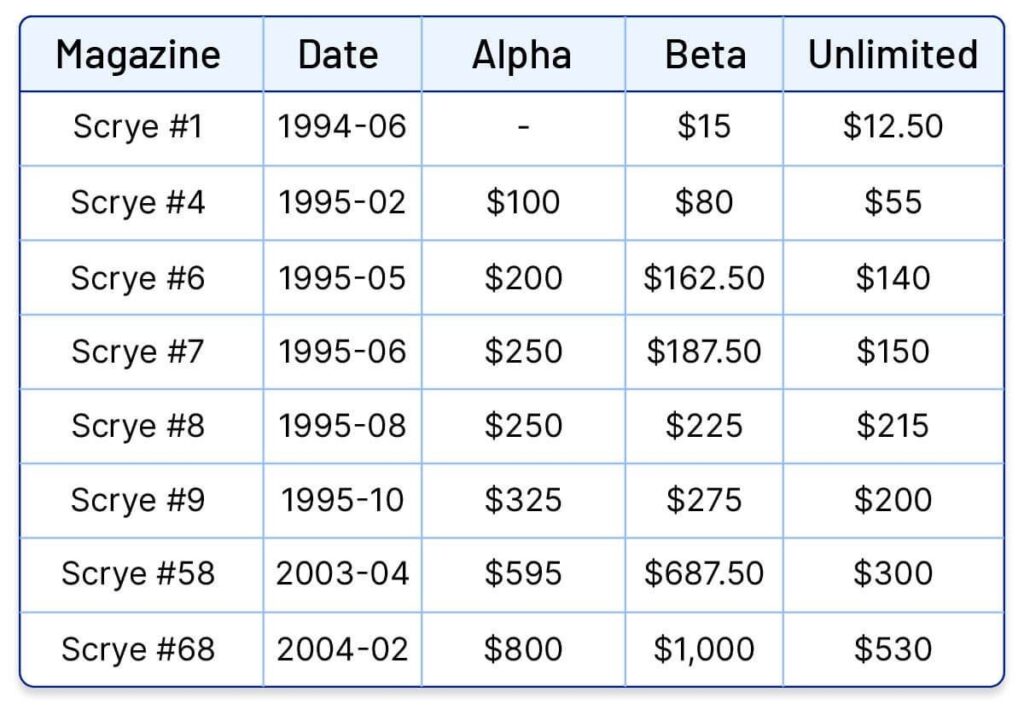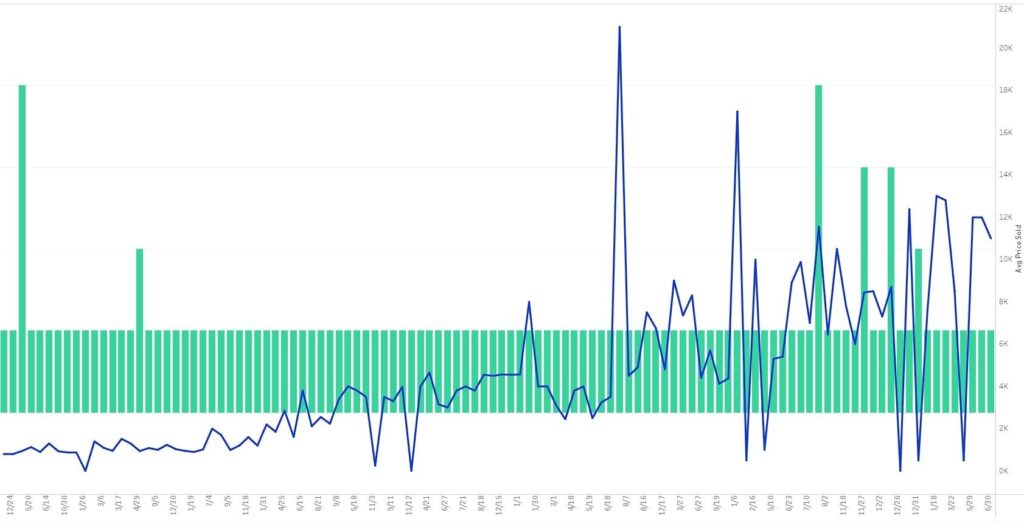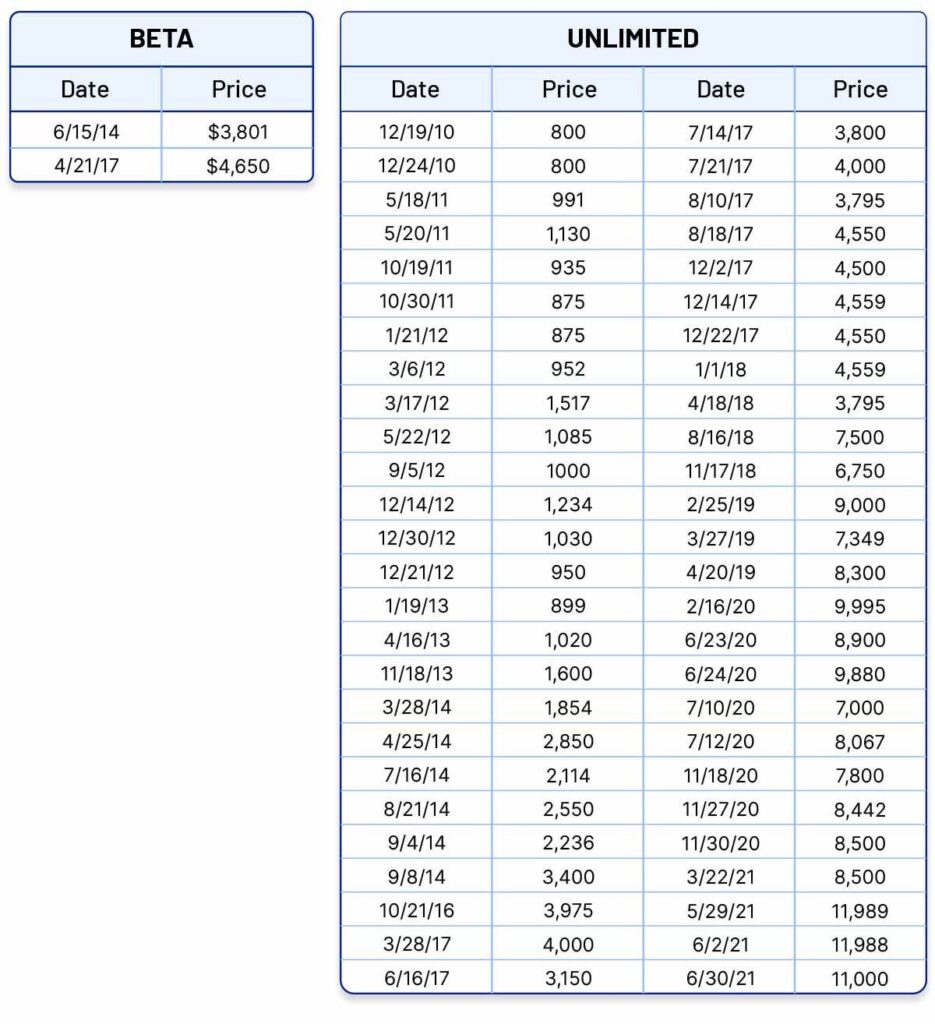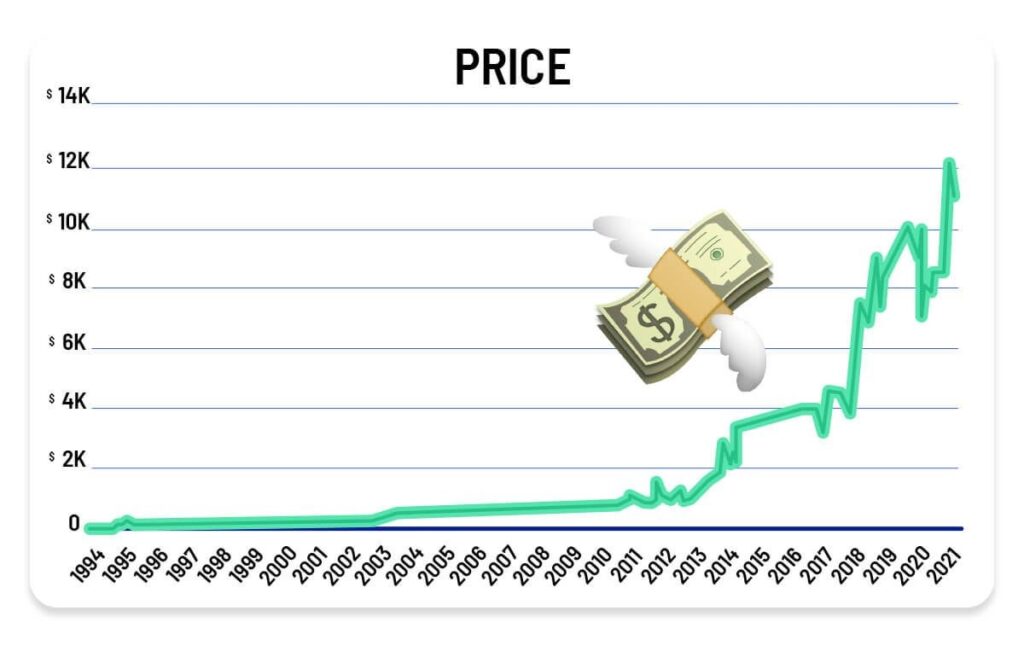How the most expensive Magic card claimed its title.
I’ve purchased Black Lotus twice in my life, and it was actually the same copy both times.
Black Lotus Unlimited Edition | Rare

The first time I found my Lotus was November of 2008. I answered a classified ad on Los Angeles Craigslist for a collection that included the entire Power Nine as well as a full set of Unlimited Dual Lands. If that ad were posted today, it would receive approximately seven thousand messages in its first three minutes after going live. Back then, however, I simply had to up my offer from the $600 he was asking to about $1,000 to fend off the competition.
An absurd deal, yes, but it was about half of my available savings at the time and absolutely terrifying to commit to. I was in the middle of a four-day temp job filing receipts for the accounting department of a reality TV production company; my first “real job” after moving to LA several months earlier, and I knew that 32 hours at $11/hour wouldn’t come close to covering that month’s rent. I went for it, though, and ended up doing the exchange in a Home Depot parking lot just after dusk. Thank goodness. I needed the money I made from that collection to survive the coming year.
A few years later, when I’d finally gained stable employment, the man who had purchased my entire set of Power reached out to me and asked if I wanted to buy his entire collection. The Power was Unlimited, and it was in very poor condition, but it was still Power. He had also amassed a complete set of every other expansion released to date, which still boggles my mind. This was in the pre-Modern era, so it was less impressive than it would end up being just a few months later, but I still agreed to pay $10,000 cash for everything. I drove up to the Bay Area, gave him a check, and dropped him off at the Apple Store on my way back south.
A few years after that, I decided to get my set of Power professionally altered. Since they were in heavily played condition, I figured it couldn’t hurt. The two big names in alteration at the time were Eric Klug and Sandreline, who has since moved on to customized leather jackets and high-end sneakers. I reached out to Sandreline first, and we ended up spending several months collaborating on a set of Power Nine alterations based on pulp sci-fi covers of the 1940s and 1950s. I wanted each card to represent one of the nine planets in the solar system, with Black Lotus as Earth and Timetwister as Pluto. Mailing my entire set of Power to France was terrifying, but the results were well worth it:

When I got the set back, several of my friends asked me what it would take to sell the set.
“I don’t know,” I said, “I’d have to at least get $10,000.”
This answer usually received a polite laugh in return. At the time, that was an absurd price for a set of played Unlimited Power, and it reflected all of the time and effort I’d put into making the alterations feel exactly right. These days, I’d have hundreds of people whipping out their wallets at that price point. The Power Nine, and Black Lotus especially, have soared to absurd heights over the past decade and show no signs of ever falling off.
And that, at long last, brings me to the subject of this week’s article: the price history of Black Lotus. Why Lotus? Well, it’s Magic’s most famous and most expensive card. Anyone who has ever heard of Magic knows about Black Lotus, even if they don’t know what it does or why it’s so darned expensive. For the Pokémon crew, Black Lotus isn’t so much Magic’s answer to Charizard as Charizard is Pokémon’s answer to Black Lotus. It is epic, legendary, and very, very rare. If you’ve ever held one in your hand, you probably remember exactly where you were when it happened.
But did you know that you used to be able to buy a Black Lotus for less than the cost of a pizza delivery? It’s true—and I have proof. So how did we get from there to this auction at the start of 2021, when a single copy of Black Lotus sold for $511,100? That’s what we’re going to find out. Strap in, friends, because we’ve got to go all the way back to 1994 to start this particular adventure.
The earliest price guide information I can find on Black Lotus is from Scrye Magazine Issue #1, published in June, 1994. At the time, a Beta copy of Black Lotus would set you back $22.50—on the high end. The median price point was $15, and you could snag a copy for $9.75 if you got really lucky. The Moxes were also selling for about $20 each, and the other really expensive cards were things like Shivan Dragon, Cyclopean Tomb, and Lich. If you really want to feel like you’re adrift in an alien land while reading these prices, know that Granite Gargoyle was worth more than several Dual Lands, and Royal Assassin was worth more than all of them.
If you haven’t been playing Magic since the dial-up era, you might not be familiar with Scrye Magazine. For many years, it was the gold standard for Magic prices. The internet was around in 1994, but it was nothing like it is today—or even like it would be just a few years later. Price guides could not update in real time back then, so if you wanted to buy, sell, or trade a card, you used the prices in the most recent issue of Scrye as your North Star. Heck, many of the stores I frequented as a kid used Scrye to price the cards in their cases, even almost a decade later.
To that end, Scrye feels like the best way to talk about the early price history of Black Lotus. Thanks to the fine folks at The Internet Archive, I have access to eight old issues of Scrye, most of which are from the Magazine’s earliest publication dates. Here’s what I was able to glean:

While this data set is frustratingly incomplete, we can see a snapshot of Magic in the middle of its first period of runaway success. Black Lotus more than quadrupled in the six months from Issue #1 to Issue #4, and then more than doubled again in the three months between Issue #4 and #6. The price kept increasing throughout 1995, before ending up in the $200-$300 range where our early price history ends.
We like to think that card prices moved slower in the before times, but only 16 months passed between Scrye #1 in June of 1994 and Scrye #9 in October of 1995. That’s less than a year and a half. In that time, a Beta copy of Black Lotus surged from $15 to $275. That type of gain would be exceptional even today, and it’s worth remembering that runaway collectibles markets aren’t just a 2020s phenomenon. The 1990s were like this too, at least for a time.
It’s also notable that Black Lotus’ price calmed down quite a bit during the seven years between October of 1995 and April of 2003. Beta versions of the card did more than double in price over that time, but the Unlimited versions only went up about $100. The card then nearly doubled again over the next 10 months, between April of 2003 and February of 2004. Back then, at least, it seems like Black Lotus would see wild price surges followed by periods of relative stability.
It’s also worth talking about what happened to Alpha and Beta prices from 1995 to 2003. Back in the Ice Age days, Alpha cards were worth more than Beta cards because they were scarcer. By the time Legions was released, however, Beta cards were worth more. Why? Because the rounded Alpha corners made them ineligible to be played in certain tournaments under certain conditions. Some players didn’t like that, so Beta became the preferred versions of these old cards. Nobody cares much about Alpha corners these days, so Alpha cards are back to being worth more than Beta. The switch lasted more than a decade, though, and some players still prefer Beta for that reason.
I’m not sure how useful this graph actually is on the face of things, but since I have access to the data, I figured I’d generate it and we could find out together. Take a gander at the entire sales history for Black Lotus (all conditions and versions) on TCGplayer, going back to 2010:

TCGplayer price history for Black Lotus. The blue line is average price sold, the green bars are relative number of copies sold.
As you can see, not many copies of Black Lotus have ever actually sold on TCGplayer. I’m also not sure that all of these copies are legitimate sales. For instance, there have been a couple of sales in the $500 range in recent years, as you can see by those large downward spikes toward the right side of the graph. Were those actual copies of Black Lotus, or mis-listed Collectors’ Edition versions? Perhaps they were scam listings, or copies in such poor condition that half the card was eaten by a dog. It’s impossible to say without access to data that no longer exists, sadly. This sort of noise is usually easy to filter out of large data sets, but that’s a lot harder with a card that simply doesn’t sell all that often.
We’re here to find out the price history of Black Lotus, though, so I’m going to do something that wouldn’t pass any sort of scientific muster: narrow our search, and discard the data points that don’t make sense. This would be grounds for any study to get summarily kicked out of a scientific journal, but since our little research project is just for fun, I’m going to do the thing that I think will help get us closer to our answer.
So. The first thing we’re going to do is eliminate all the Near-Mint (NM) and Heavily Played (HP) copies of Black Lotus. That removes outliers on both sides, either flawless graded copies or dog-eaten cards. Then I’m going to kick out any sale that looks glaringly low—the $5 sales that could have just been a mis-listing by someone unfamiliar with the TCGplayer interface. Then we’ll sort by Alpha, Beta, and Unlimited, and build a price chart of every confirmed sale by date. Here’s what that table looks like:

First, the bad news. We have no usable data for Alpha at all, and only two confirmed Beta sales in this condition range. We can’t say much about the price history of Alpha or Beta in this timeframe, though it does appear that the card went up in price from 2014 to 2017—no shocker there. I can’t say how much without knowing more about the condition of those two specific copies of Black Lotus.
The good news, however, is that we actually do have some pretty solid data for Unlimited copies of Black Lotus. The data spans over a decade, and you can see the card surge from the $800 range in late 2010 to roughly $11,000 here in the middle of 2021. This is roughly a 14-fold gain over 10 years. That would seem impressive if the card hadn’t climbed 44-fold between 1994 and 2004. Black Lotus: a very impressive Magic card!
At any rate, I’ve put together a very rough price chart covering all of the Scrye data plus all of the TCGplayer data. Comparing price guide values to sold comps is a bit rough, and we’re missing a lot of data, but here’s a rough picture of Unlimited Black Lotus’ price history from 1994 through today:

Looking at this chart, it’s shocking how exponential it looks. Nearly all of the card’s price history from 1994 through 2011 is dwarfed by its price history over the following decade, which is just a messy curve pointing toward the ceiling.
There’s nothing that WotC can do to stop this surge, either. Even if they axed the Reserved List and reprinted Black Lotus tomorrow, the original copies would hold massive collector value simply due to how scarce they are and what they represent about the game’s early years. While reprinting a card like Gaea’s Cradle would tank the price, since most people who own that card simply want it for their decks, reprinting Black Lotus would be like reprinting Mickey Mantle’s rookie card. The people spending $11,000 on these are doing it because of its status as a collectible, not as a game piece.
To that end, I feel like Black Lotus’ growth hasn’t come close to topping out. Even if the Magic market were to collapse, and I don’t think it will, Black Lotus has more in common with Action Comics #1 than Jace, the Mind Sculptor. It is a holy grail collectible, and it will be for at least the duration of our lifetimes. It might not keep up this exponential growth, and it might plateau or even drop for a while, but I bet the average price of an Unlimited Black Lotus will be over $25,000 a decade from now. There might be safer high-end investments in the collectibles world, but I can’t think of any off the top of my head.
Graded Mayhem
We started this article by looking at a $500,000 copy of Black Lotus, but that graph tops out around $11,000. What gives?
First off, Alpha and Beta copies of Black Lotus are worth quite a bit more than Unlimited copies. It isn’t just the look, either—it’s scarcity. We have pretty good intel stating that there were only ever 1,008 copies of every Alpha rare even printed, and only 3,025 copies of each Beta rare. There were 17,700 copies of each Unlimited rare ever printed, making them about five times more common. That’s still an absurdly low print run, especially when you factor in how many copies have been lost to time or will simply never again hit the market, but there’s a massive scarcity gap here. Right now, the cheapest Unlimited Lightly Played (LP) copy of Black Lotus listed on TCGplayer is $19,500. The cheapest LP Beta copy is $44,700. There are no Alpha copies listed for sale in any condition.
Of course, most copies of Black Lotus aren’t sold loose anymore. Instead, players pay services like PSA or Becket to assign them a 1-10 grade based on their condition and put them in a snazzy plastic case. While the grading craze that has hit sports cards over the past few years hasn’t fully made its way into Magic—you can’t play slabbed cards in your decks, after all—Black Lotus is exactly the kind of card that you nearly always want to get graded. As with other high-end collectible cards, the difference in value between, say, a PSA 5 and a PSA 8 are going to be massive.
This is honestly the number one thing about the collectables market that I wish I could get everyone to understand. Articles like “Black Lotus sells for $500,000!” go viral, and everyone starts to believe that all Black Lotuses are worth this much. It just isn’t true. The half-million-dollar Black Lotus is a gem mint PSA 10 from Alpha. It is also signed by Christopher Rush, who passed away in 2016. I can state without any hyperbole that this exact Magic card is the most expensive Magic card ever printed, and it always will be. There are only seven PSA 10 Alpha Black Lotuses in the world, and probably no more with the potential to get such a grade. Even most pack fresh cards from that era don’t come back as a 10 due to scuffs or dings or centering issues. It is one of a kind, and it is the gold standard.
Even here, in the high-end graded market, you can see what has happened to the market in recent years. According to an older Polygon article on the graded Lotus market, a BGS 9.5 Alpha Lotus sold for $87,672 In July of 2018, and another BGS 9.5 sold for $166,100 in March of 2019. That’s a doubling in less than a year. I also found a Reddit thread with some older price data for graded copies of the card, showing that PSA 9 copies of Black Lotus were selling in the $2,200-$3,600 range back in the winter of 2004. This follows a similar exponential-ish chart to the ungraded copies of Unlimited Black Lotus that we looked at earlier.
Want to buy a graded Alpha Black Lotus right now? eBay offers the following options:
| BGS 8.5 | $155,000 |
| BGS 8.5 signed | $235,000 |
| BGS 8.5 | $250,000 |
| BGS 9.0 | $500,000 |
| BGS 9.5 | $799,999 |
| BGS 9.5 signed | $1,200,000 |
These are just asking prices, not sold prices, and nobody would buy these cards without doing some serious haggling first. Nobody is going to pay $700,000 more(!) than that gorgeous PSA 10 copy for this signed BGS 9.5. Even still, it’s a good way to see just how stark the price differences shift based on condition. If you’re comparing Lotus prices on the high end, condition is absolutely everything.
Where will the graded Lotus market go? Up, probably, though maybe not soon. The graded sports card and Pokémon card markets both exploded in 2019 and 2020, followed by something of a downturn here toward the middle of 2021. While Magic hasn’t been affected as much, some Reserved List cards have dropped in price over the past few months after surging in February and March. Short term, it is quite possible that some money will pull out of this market and there will be some “deals” to be had on Black Lotus.
Long term, I feel just as bullish about these elite graded Alpha copies of Black Lotus as I do about ungraded Unlimited copies. These are the holiest of holy grails, and they are untouchable. As long as the global economic system continues to allow a tiny number of people to hoard massive amounts of wealth that can be spent on high end luxury items, these cards will keep rising in price.
